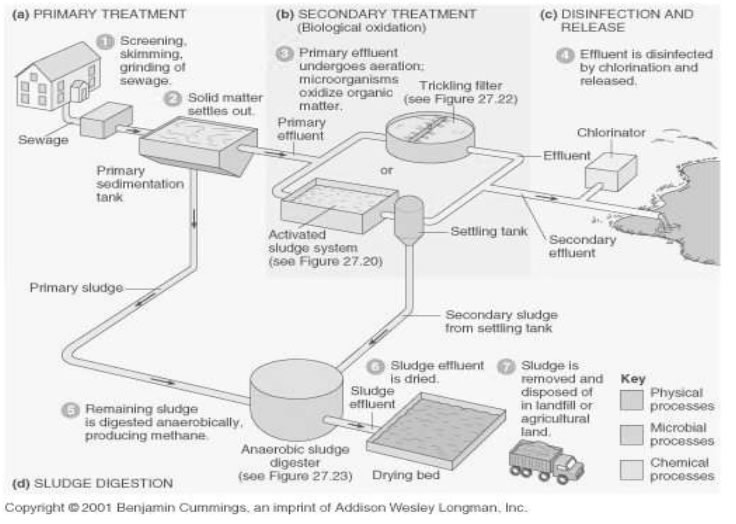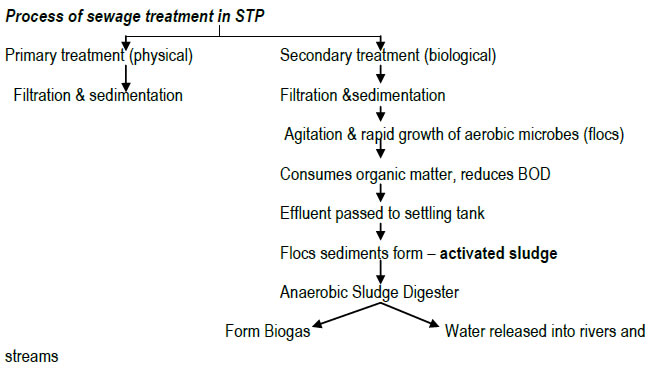
microbes in human welfare project, microbes in human welfare wikipedia, biology 12th, 12th biology, microbes in household products, cbse class 12 biology notes , microbes in human welfare 12 notes, class 12 biology notes, microbes in human welfare class 12, microbes in human welfare class 12 notes, class 12 microbes in human welfare, note biology, biology notes, microbes in human welfare, class 12 cbiology chapter 10 notes, 12th standard biology notes, 12th std biology notes, class 12 biology notes chapter 10, microbes in human welfare chapter class 12 notes
the amount of oxygen that would be consumed if all the organic matter in 1 liter of water was oxidize by the bacteria.
the use of biological methods for controlling plant disease and pets.
the organisms the enrich the nutrient quality of the soil.
the mixture of gasses (mainly CH4,
CO2) produced by the microbial activity and which can be used as fuel.
a variety of cotton which is incorporated with BT gene and it is resistant for insects pests.
the microbial product for removing clots from the blood vessels of the patients who have undergone myocardial infraction leading to heart attack.
the process of anaerobic respiration in which the complex molecules incompletely brakes into simple ones by the microbial action.
the containers made up of large amount of CH4, CO2 and H2 as they grow on cellulosic material.
A symbiotic relation between fungal hyphal and roots of
the tree
(Higher plant)
organism that destroys crop or its products is known as pest.
the waste- water containing large amount of organic matter and microbes.
• E.g. Thermal vents of geyser (Temp. above 1000c)
• Deep in soil.
• Under snow.
• Diverse. Protozoa, Bacteria, Fungi, Virus, Viroids, Prions (Proteinaceous infectious agents)
• Useful : Antibiotics.
•
Harmful : cause diseases.
• Everyday : Lactobacillus (LAB) Lactic acid Bacteria – form curd from milk.
•
Increase Vit . B12
•
Check disease causing microbes in our stomach.
•
Fermentation of dough for dosa, idli (CO2 produced)
•
Making bread –Baker‘s yeast.Saccharomyces cerevisiae.
•
Toddy made from sap of palm.
•
Cheese making (eg.Swiss cheesse by Propionibacterium sharmanii, Roquefort cheese by fungi.)
Beverages and antibiotics.
• Fermentors :Large vessels for growing microbes.
• Beverages like wine, bear, whisky, Brandy, Rum (Saccharomyces cerevisiae) Malted cereals and fruit juices used to produce ethanol, wine and beer produced without distillation. Whisky, brandy, rum produced after distillation.
• Penicillin produced by Alexander Fleming from Penicillium notatum while working with Staphylococci
Earnest Chain and Howard Plorey awarded Nobel Prize in 1945 for establishing Penicillin as an
effective antibiotic.
•
Uses : Treat diseases like plague, whooping cough, diphtheria, leprosy.
• Chemicals : Enymes and other Bioactivities Molecules:
• Uses:
• Aspergillus niger for production of Citric Acid.
• Aspergillus niger for production of Citric Acid.
• Acetobacter aceti for production of Acetic Acid.
• Clostridium butylicum for production of Butyric Acid.
• Lactobacillus for production of Lactic acid.
• Lipases used in detergents to remove oil strains from Laundry.
• Pectinases and Proteases to clarify bottled jucies.
• Streptokinase (from Streptococcus) as clot buster in patients with myocardial infraction (heartattack).
• Cyclosporin A– an immuno-suppresant used in organ transplant patients (produced by Trichoderma polysporum)
• Statins produced by yeast Monascus purpureus used as blood, cholesterol lowering agent.
Why treatment necessary ?
• Major component of waste water, human excreta.
• Waste water sewage.
• Cannot be disposed directly into rivers and streams.
Where & how ?
• Before disposal sewage treated in sewage treatment plants (STPs)
• Treatment done in two stages.
• Primary : Physical removal of particles large and small by filtration and sedimentation.
• Solids – primary sludge.
• Supernatant – effluent.
• Secondary : Primary effluent taken to large aeration tanks.
• Agitated mechanically and air pumped into it.
• Aerobic microbes form masses with fungal filaments flocs.
• Microbes consume organic matter in effluent for growth.
• BOD ( Biological oxygen demand) reduced.
• Passed into settling tank.
• Bacterial flocs sedimented (activated sludge)
• Small part of activated sludge used as inoculums in aeration tank.
• Major part pumped into large anaerobic sludge digesters.
• Anaerobic bacteria digest bacteria and fungi.
• Bacteria produce gases such as methane, hydrogen sulphide and CO2 – Biogas.
• Secondary effluent released into rivers and • streams.
• No man made technology available till date.
• Untreated sewage if released into rivers causes pollution.
• Ministry of environment and Forests initiated, Ganga Action Plan and Yamuna Action Plan.

• Concrete tank 10- 15 meters deep, slurry or dung fed.
• Floating cover placed above rises as biogas content rises.
• Connecting pipe for supply of biogas.
• Used for cooking and lighting.
• Development by IARI :- Indian Agriculture Research institute & KVIC : Khadi and village Industries Commission.
• Insecticides and Pesticides toxic, harmful & are pollutants.
• Natural predation better method.
• No of pests kept in check, not totally eradicated.
• Food chains not disturbed
• Eg. Ladybird and Dragon flies useful to get rid of aphids and mosquitoes.
• Bacillus thuringiensis (Bt) used to control butterfly caterpillar.
• Mode of spores operation.
o Available is sachets, mixed with water and sprayed on plants.
o Eaten by insect larva
o Toxin released in gut kills larvae.
• Now Bt toxin genes introduced into plants – resistant to insect pests.
e.g. Bt cotton.
• Tungus trichoderma now being developed.
• Nucleo polyhedrovirus good for narrow spectrum insecticide applications.
• No negative impacts on plants, mammals, birds, fish or target insects.
• For overall IMP (Intergrated pest Management) programme.
• For ecologically sensitive areas.
• Chemical fertilizers major pollutant.
• Switch to organic farming and use of biofertilizers need of the time.
• Main sources of biofertilizers. Bacteria, Fungi & Cyanobacteria. Eg Rhizobium present in roots of leguminious plants fix atmospheric nitrogen into usable organic form. Azospirillium and Azotobacter free living bacteria – fix atmospheric Nitrogen.
• Symbiotic Associations
• Eg.Genus Glomus sp. form mycorrhiza
• Fungal symbiont absorbs phosphorus from soil and passes it to plant.
• Plants show
o resistance to root – borne pathogens.
o Tolerance to salinity and drought
o Increase in growth and development.
• Cynobacteria– autotrophic – fix atmospheric nitrogen
• Imp.biofertilizer. e.g. Anabaena, Nostoc, Oscillatoria.
• Blue green algae – increase fertility by adding organic matter.
• No. of biofertilizers are commercially available.
• biodegradable plastic, e.g. polyhydroxybutyrate (PHB) is being produced commercially by fermentation with the bacterium Alcaligenes eutrophus.
• Production of PHB may be easily achieved in tree plants like populous, where PHB can be extracted from leaves.
• Other main drawback of bacterial PHB is its high production cost, making it substantially very expensive than synthetic plastics.
• the genes encoding the antigenic proteins of virus and bacteria can be isolated from the pathogens and expressed in plants.
• such transgenic plants or their tissues producing antigens can be eaten for vaccination/immunization (edible vaccines).
• the expression of such antigenic proteins in crops like banana and tomato are useful for immunization of humans since banana and tomato fruits can be eaten raw. Example: cholera and hepatitis B vaccine.
a) Primary treatment(physical )
b) Secondary treatment(biological)
Effluent loaded in large aeration tank, Agitation & rapid growth of aerobic microbes (flocs) ,Consumes organic matter ,reduces BOD, Effluent passed to settling tank, Flocs sediments form – activated
sludge(A.S.) Poured into sludge digester(small amount of A.S. used as inoculum) Filtration & sedimentation.

Copyright @ ncerthelp.com A free educational website for CBSE, ICSE and UP board.